Embracing the Timber Age
Rake and Eave Detailing
A typical CLT roof assembly rake and eave detail is shown in Detail 10. Here, the vapor-permeable AB laps over the CLT panel edge to protect the wood end-grain. Liquid-applied flashing extends from the wall membrane to the underside of the CLT roof panel to provide an AB transition at the roof-to-wall interface.
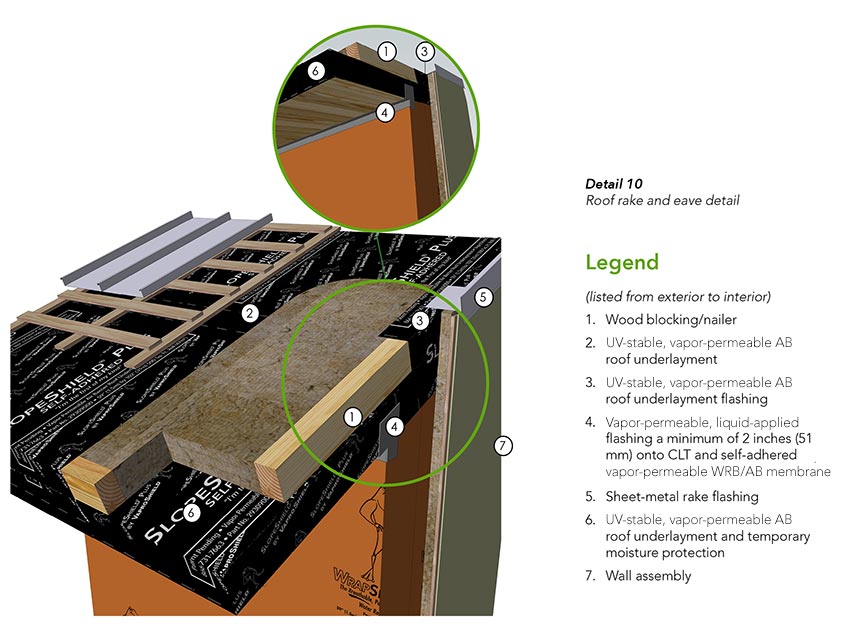
The roof-rake flashing is shown stripped into the roof underlayment to ensure that all water shedding is directed downslope toward the eave. Typically, the drainage strategy will include a gutter system at the eave to collect and drain the water runoff.
CLT Roof Design at < 2:12 Pitch
Typical components of a conventional roof assembly with a slope less than 2:12 are shown in Detail 11. In this assembly, the roof membrane is intended to act as a perfect barrier against water ingress, and the roof underlayment serves as a temporary roof membrane to protect the CLT panels during the construction phase.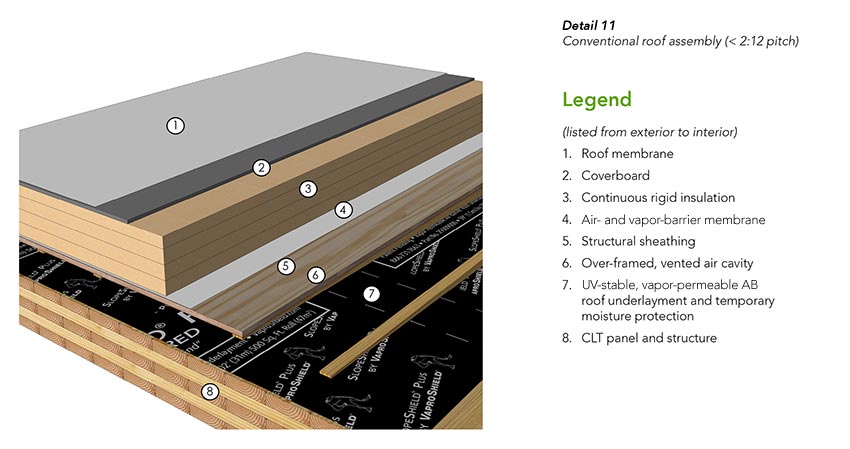
An un-sloped CLT roof panel is unable to readily shed water, so it is particularly sensitive to wetting during construction. To provide temporary moisture protection until the remaining roof assembly layers are installed, the vapor-permeable AB membrane is applied over the un-sloped CLT roof panel. With water-resistive properties, it can facilitate some panel drying while still protecting the underlying panel from bulk water when laps, penetrations, and terminations are appropriately detailed and when a means for draining the roof area of standing water is provided.
Best practice is to slope the roof membrane to the roof’s drainage and overflow system with roof drains or scuppers. Sloped over-framing provides the slope in the roof assembly shown in Detail 11. It also creates an air gap that can be used for observations to facilitate locating roof leaks, should they occur, or to provide a ventilated cavity to the interior to encourage panel drying, if required, at any stage during construction or occupancy. The vent space and over-framing provides the added benefit of helping to avoid damage to the CLT panel during future reroofing activities. The ventilation gap should not be vented to the outdoors once in service. It should be noted that local fire-safety requirements, however, may not allow a clear ventilation gap in this assembly.
Alternatively, slope may be provided by the roof insulation or the CLT panel/structure itself, as shown in Figure 3-6. In all cases, the air- and vapor-barrier membrane is provided below the insulation to prevent air leakage and vapor diffusion into the roof assembly.

Figure 3-6
Roof-Parapet Detailing
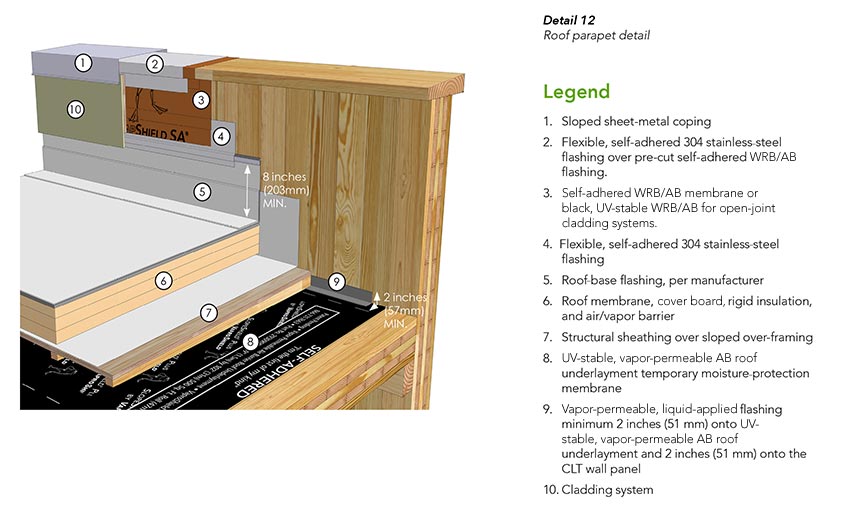
A roof-to-parapet transition is shown in Detail 12.
When using a roof underlayment as a temporary moisture-protection membrane over the CLT roof panel, the perimeter is sealed at the parapet to close off this joint to water ingress. This seal can be accomplished with a strip of vapor-permeable liquid-applied flashing.
The parapet blocking and coping slopes to the roof side of the parapet. Flashing provides the primary moisture protection for the top of the CLT wall panel. Flashing is rated for service temperatures up to 200 degrees Fahrenheit, so it can be used in most high-temperature coping applications.
Construction-Phase Considerations
The design process and construction-phase planning are often heavily intertwined in successful mass timber projects. Inappropriate moisture management of CLT during construction and building service can lead to dimensional changes, microbial growth, or general deterioration of the CLT panels and other enclosure components, according to the Canadian-based forest sector research and development firm FPInnovations’ CLT Handbook.
Therefore, it is important that a moisture management plan is developed to outline steps taken during all phases of construction to minimize CLT moisture exposure.
Building codes typically require the moisture content of wood to be less than 16–19 percent prior to cover. However, many of these guidelines were developed with lightweight wood-framed construction in mind and do not consider the hygric mass of mass timber elements. Thus, it is typically advisable to limit the moisture content of CLT wall, floor, and roof panels to the lower end of this range—approximately 16 percent at all locations—prior to cover.
If CLT is wetted to above the maximum moisture levels during construction, drying of the CLT panel can take a substantial amount of time and lead to costly construction delays. Drying can be enhanced with a combination of heat and ventilation. However, drying of an already wetted panel does not eliminate the risks for permanent damage and panel distortions caused by fluctuating moisture content and rapid dimensional changes, particularly if the drying rate is too high.
Construction tenting can help eliminate moisture-related risks during construction, but some projects do not have the means to provide this protection. As an alternative, one step to reduce the potential moisture exposure is to take advantage of the pre-application of water-resistive membranes off-site. Pre-applying a CLT panel with a water-resistive membrane offers the benefit of protection during shipping and staging on-site and can reduce the building dry-in period. These membranes also remain part of the building’s final enclosure design. Thus, an additional membrane application or the removal of temporary membranes is often not necessary.
Once the CLT panels are erected on-site, the exposed faces and edges of the CLT panel, including joints, rough openings, and penetrations need to be treated. A sequence specific to preinstalling a self-adhered WRB/AB over CLT wall panels is shown on Detail 13. Once erected in the field, recommended detailing for panel joints at wall areas is shown in Detail 14a and for roof areas in Detail 14b.
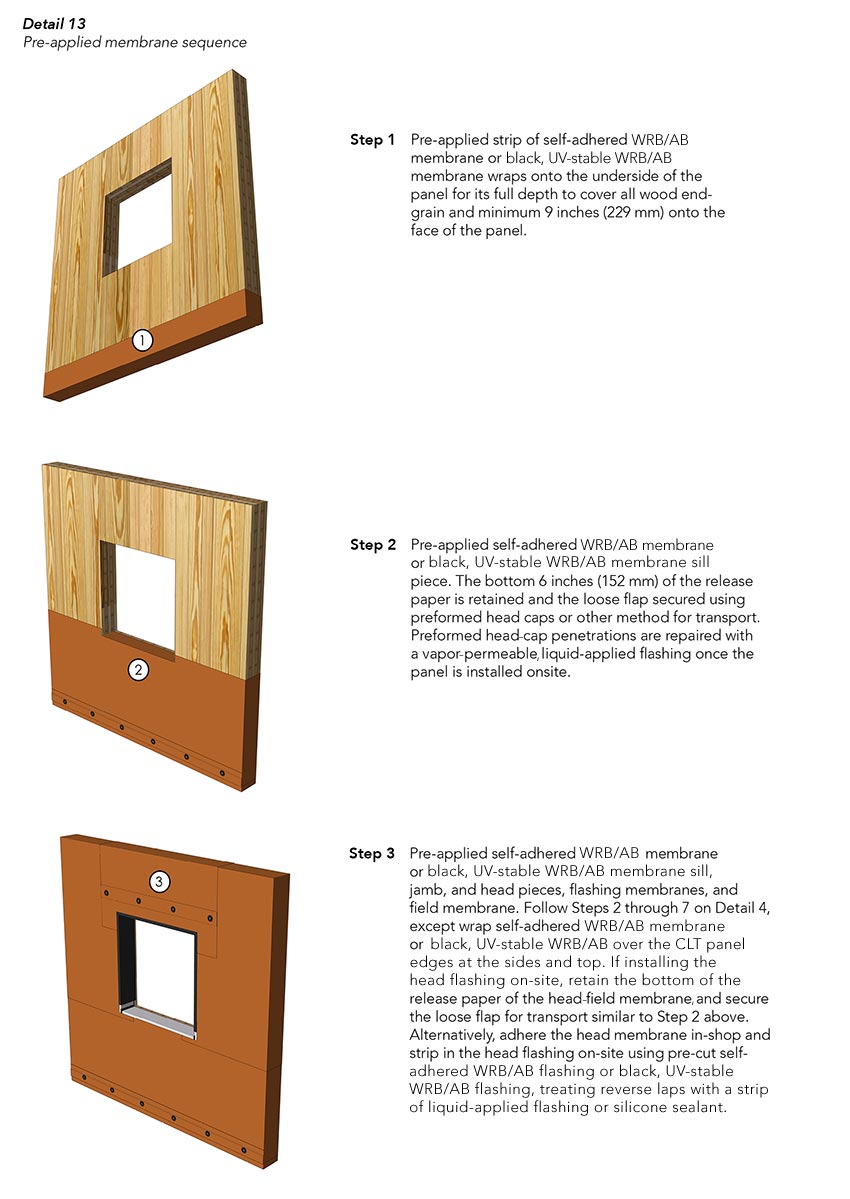
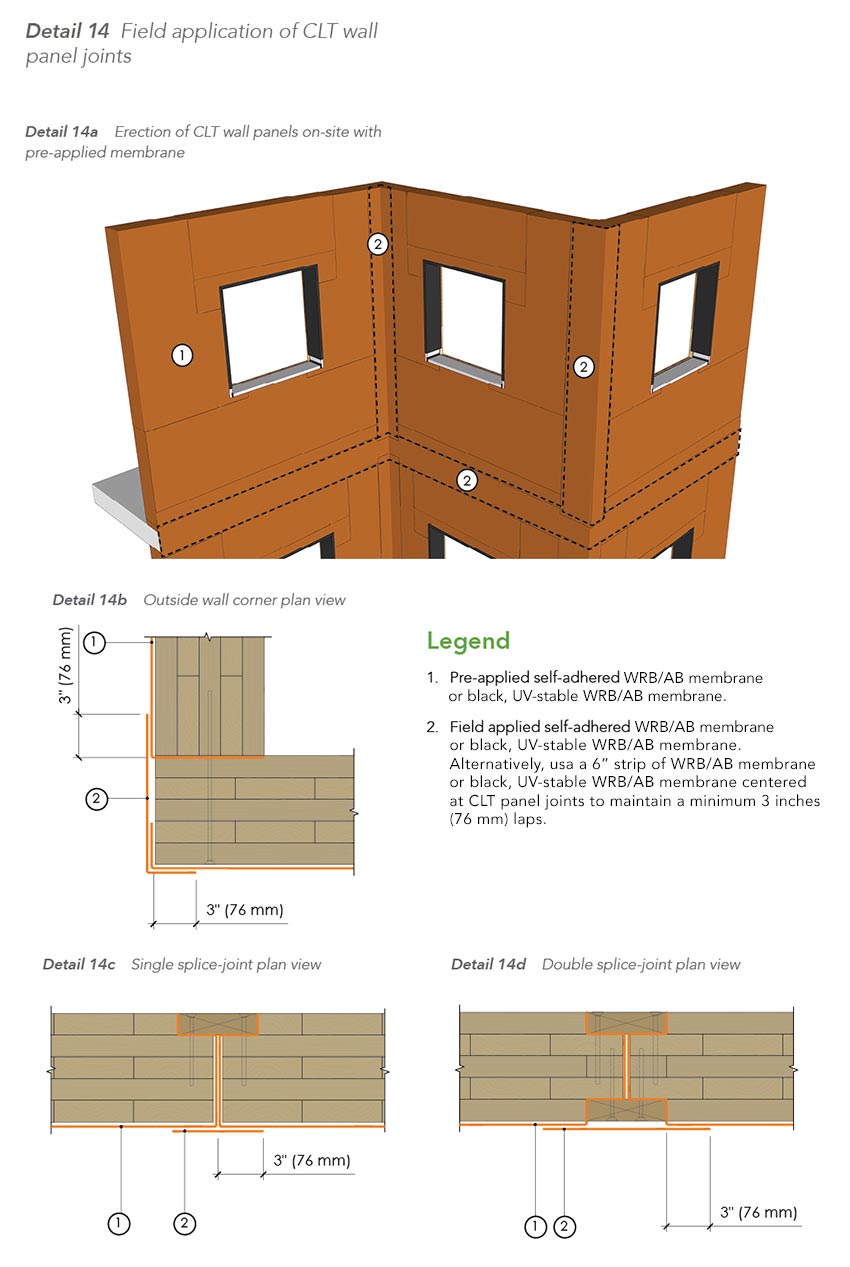
In horizontal roof and floor applications, the CLT panel will be laid horizontal, or near horizontal, to form the roof or floor deck, increasing the CLT’s moisture exposure as compared to wall or sloped-roof applications. Thus, extra precautions and planning may be required. A roof underlayment may be used as a temporary protection membrane over un-sloped or low-sloped CLT in most instances, as shown in Detail 11. Note that ponded water may begin to slowly pass through the membrane to wet the CLT over time. However, this technology has been tested to demonstrate that 24 inches (210 mm) of standing water over the membrane will not result in water leakage over a 24-hour period. This tested water depth exceeds what would be reasonably expected in the field. At the same time, it should be noted that this test is performed in the middle of the sheet membrane. Laps, penetrations, and terminations are at the highest risk for moisture intrusion, so they require appropriate detailing and effective moisture management practices during the construction phase to minimize wetting risks.
While the properties of the roof underlayment offers many benefits for the moisture management of CLT by permitting outward drying, it may not be appropriate for use as a temporary roof protection membrane in regions with a high risk for wood decay due to this same property. The Nail-Laminated Timber Design & Construction Guide classifies regions as high risk for wood decay when the local Scheffer Climate Index exceeds 70. Within the scope of this guide, put out by the Binational Softwood Lumber Council, high-risk regions include some coastal areas of the north Pacific and some Appalachian regions. A more appropriate option for moisture protection in these regions may be a factory-applied, fully adhered, vapor-impermeable waterproof membrane if installation is expected to occur during wet seasons. If this strategy is followed, it is especially important that a durable membrane is used and that all membrane laps are fully sealed prior to water exposure because any moisture that bypasses the protective membrane will be very difficult to dry without removal of the vapor-impermeable membrane.
Additional methods and measures that may be included in the moisture-management plan are:
- Water-repellent coatings: Factory-applied, this coating can help limit the CLT’s moisture uptake. Ideally, the coating is moderately vapor permeable to maintain the drying potential of the CLT. Pre-applied coatings can be particularly valuable at panel edges where moisture uptake through the wood end-grain is quicker. Water-repellent coatings may not be appropriate, as the sole form of protection in the higher-risk regions for wood decay since these coatings are not 100 percent effective if exposed to moisture for prolonged periods, as stated in RDHBuilding Science’s “CLT Floor Moisture Testing Report: UBC Brock Commons Tall Wood Student Residence.” It should also be noted that water-repellent coatings do not address potential gaps between CLT laminations or water ingress at CLT panel joints, which can otherwise be bridged by sheet membrane products. Water-repellent coatings should also not be relied upon to provide in-service water control, and thus a separate water-resistive membrane will still be required for CLT enclosures.
- Shipping coordination and protection: By coordinating shipping with the construction schedule, just-in-time delivery principles can be used to limit the period of time that CLT panels will be staged on-site, therefore reducing CLT exposure to on-site sources of moisture. Pre-installation of membranes during panel fabrication can provide some protection of the panels during shipping. However, additional protection may be required depending on the season, climate, and distance of the fabrication facility from the job site.
- Site protection: CLT panels may need to be stored on-site prior to being erected onto the building. Site protection may be necessary to reduce the panel’s exposure to moisture, depending on the season and climate. Where membrane products are pre-installed prior to delivery, moisture protection during storage may be minimized.
- General water management: Moisture uptake occurs over time, and thus short-term exposure periods may be tolerated provided that conditions for drying exist after the wetting event, according to the Nail-Laminated Timber: U.S. Design & Construction Guide. General procedures for limiting the bulk-water exposure time during erection and prior to final cover are imperative for managing the wetting risk. This should include plans to clear ponding water from horizontal CLT areas, including snow and ice, in a timely manner. Pre-applying membranes and treating penetrations and joints once the panels are erected can also be used to reduce the exposure. However, as previously mentioned, removal of ponded water over vapor-permeable membranes should still be a priority during construction.
While an effective use of these strategies can reduce the risk for introducing construction moisture into CLT, the in-service moisture performance of the enclosure can still significantly impact the CLT structure. For this reason, it is important to follow the previously delineated guidelines to ensure that the CLT assembly is able to effectively manage in-service water and vapor loads.
Summary
Mass timber and CLT construction offers many advantages, including enhanced modularity, reduced construction schedules, improved thermal performance, and material sustainability.
However, mass timber’s propensity to absorb moisture from the environment and the relative vapor impermeability of CLT panels introduces unique challenges when incorporated with the building enclosure. These challenges should be considered during design and construction phases to ensure long-term performance.
Highly vapor-permeable WRB/AB membranes can be used to effectively manage water and air in CLT wall and roof assemblies and allow outward drying of the CLT while in service. Additionally, they offer enhanced fire and UV performance.
Foresight and planning are required during the construction phase to effectively manage CLT exposure to construction moisture and to minimize risks of in-service enclosure performance issues or construction delays. Pre-applying membranes to the CLT off-site can play an integral role in the construction-phase water-management strategy in addition to potentially reducing the construction schedule. More general water management strategies should also be in place to provide additional protection and prevent prolonged periods of ponded water depending on the climate and season.









